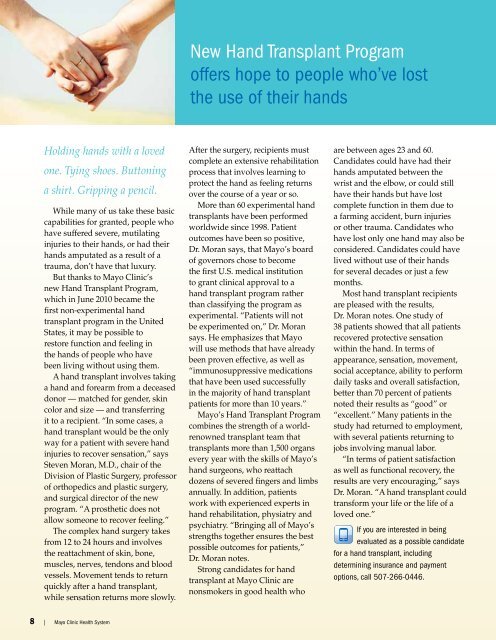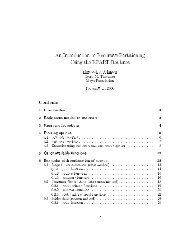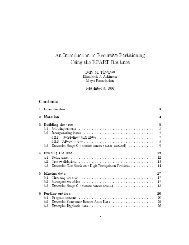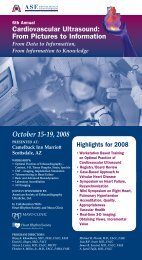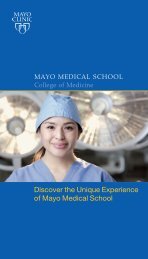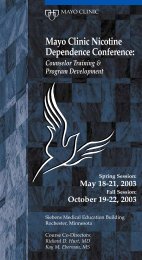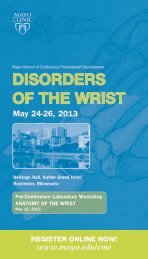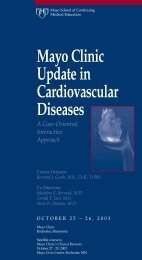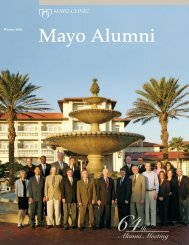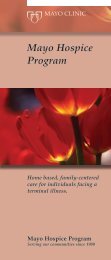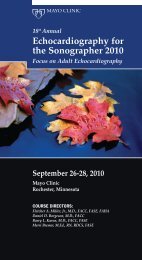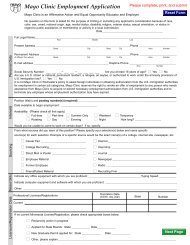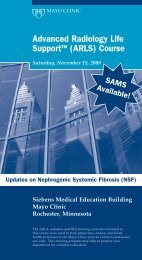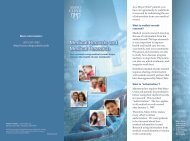Hometown Health Newsletter: Western Region ... - Mayo Clinic
Hometown Health Newsletter: Western Region ... - Mayo Clinic
Hometown Health Newsletter: Western Region ... - Mayo Clinic
You also want an ePaper? Increase the reach of your titles
YUMPU automatically turns print PDFs into web optimized ePapers that Google loves.
New Hand Transplant Program<br />
offers hope to people who’ve lost<br />
the use of their hands<br />
Holding hands with a loved<br />
one. Tying shoes. Buttoning<br />
a shirt. Gripping a pencil.<br />
While many of us take these basic<br />
capabilities for granted, people who<br />
have suffered severe, mutilating<br />
injuries to their hands, or had their<br />
hands amputated as a result of a<br />
trauma, don’t have that luxury.<br />
But thanks to <strong>Mayo</strong> <strong>Clinic</strong>’s<br />
new Hand Transplant Program,<br />
which in June 2010 became the<br />
first non-experimental hand<br />
transplant program in the United<br />
States, it may be possible to<br />
restore function and feeling in<br />
the hands of people who have<br />
been living without using them.<br />
A hand transplant involves taking<br />
a hand and forearm from a deceased<br />
donor — matched for gender, skin<br />
color and size — and transferring<br />
it to a recipient. “In some cases, a<br />
hand transplant would be the only<br />
way for a patient with severe hand<br />
injuries to recover sensation,” says<br />
Steven Moran, M.D., chair of the<br />
Division of Plastic Surgery, professor<br />
of orthopedics and plastic surgery,<br />
and surgical director of the new<br />
program. “A prosthetic does not<br />
allow someone to recover feeling.”<br />
The complex hand surgery takes<br />
from 12 to 24 hours and involves<br />
the reattachment of skin, bone,<br />
muscles, nerves, tendons and blood<br />
vessels. Movement tends to return<br />
quickly after a hand transplant,<br />
while sensation returns more slowly.<br />
After the surgery, recipients must<br />
complete an extensive rehabilitation<br />
process that involves learning to<br />
protect the hand as feeling returns<br />
over the course of a year or so.<br />
More than 60 experimental hand<br />
transplants have been performed<br />
worldwide since 1998. Patient<br />
outcomes have been so positive,<br />
Dr. Moran says, that <strong>Mayo</strong>’s board<br />
of governors chose to become<br />
the first U.S. medical institution<br />
to grant clinical approval to a<br />
hand transplant program rather<br />
than classifying the program as<br />
experimental. “Patients will not<br />
be experimented on,” Dr. Moran<br />
says. He emphasizes that <strong>Mayo</strong><br />
will use methods that have already<br />
been proven effective, as well as<br />
“immunosuppressive medications<br />
that have been used successfully<br />
in the majority of hand transplant<br />
patients for more than 10 years.”<br />
<strong>Mayo</strong>’s Hand Transplant Program<br />
combines the strength of a worldrenowned<br />
transplant team that<br />
transplants more than 1,500 organs<br />
every year with the skills of <strong>Mayo</strong>’s<br />
hand surgeons, who reattach<br />
dozens of severed fingers and limbs<br />
annually. In addition, patients<br />
work with experienced experts in<br />
hand rehabilitation, physiatry and<br />
psychiatry. “Bringing all of <strong>Mayo</strong>’s<br />
strengths together ensures the best<br />
possible outcomes for patients,”<br />
Dr. Moran notes.<br />
Strong candidates for hand<br />
transplant at <strong>Mayo</strong> <strong>Clinic</strong> are<br />
nonsmokers in good health who<br />
are between ages 23 and 60.<br />
Candidates could have had their<br />
hands amputated between the<br />
wrist and the elbow, or could still<br />
have their hands but have lost<br />
complete function in them due to<br />
a farming accident, burn injuries<br />
or other trauma. Candidates who<br />
have lost only one hand may also be<br />
considered. Candidates could have<br />
lived without use of their hands<br />
for several decades or just a few<br />
months.<br />
Most hand transplant recipients<br />
are pleased with the results,<br />
Dr. Moran notes. One study of<br />
38 patients showed that all patients<br />
recovered protective sensation<br />
within the hand. In terms of<br />
appearance, sensation, movement,<br />
social acceptance, ability to perform<br />
daily tasks and overall satisfaction,<br />
better than 70 percent of patients<br />
noted their results as “good” or<br />
“excellent.” Many patients in the<br />
study had returned to employment,<br />
with several patients returning to<br />
jobs involving manual labor.<br />
“In terms of patient satisfaction<br />
as well as functional recovery, the<br />
results are very encouraging,” says<br />
Dr. Moran. “A hand transplant could<br />
transform your life or the life of a<br />
loved one.”<br />
If you are interested in being<br />
evaluated as a possible candidate<br />
for a hand transplant, including<br />
determining insurance and payment<br />
options, call 507-266-0446.<br />
8 | <strong>Mayo</strong> <strong>Clinic</strong> <strong>Health</strong> System<br />
i i i


